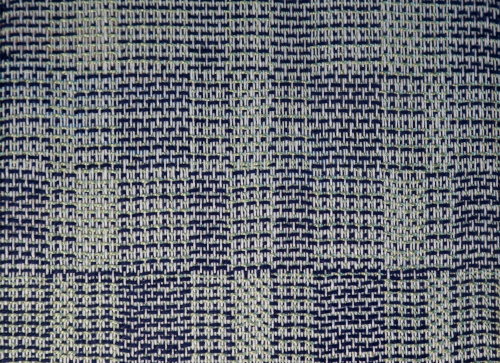Samples #19 - 22 of my 4-shaft crackle manners of weaving sampler.
I did a blog post earlier this year on The Italian Manner, when I was working on my
Cottage Windows table runner. In reviewing it for my 4-shaft crackle sampler, I also looked through
my books again, and found several variations of Italian manner (or
Italian style) to try.
Definition: A three-color
polychrome
treadling that alternates pattern weft with background wefts woven on opposite
sheds instead of tabby.
-
Tabby is plain weave woven between pattern weft shots. It alternates
shafts 1 & 3 with 2 & 4 and provides a stable structure to hold
the pattern.
- On opposite instead of tabby means alternating either shafts
- 1 & 2 with 3 & 4
- 2 & 3 with 1 & 4
-
These are called "background" wefts instead of "tabby" for Italian manner
weaving.
In exploring my weaving resources, I found three variations of Italian
manner.
- 3-shuttle
- classic crackle
- Lyons Italian style
Lucy Brusic includes 2-shuttle and 1-shuttle Italian manner in her book, but
since they don't conform with even her own definition, I didn't do them. I
think they more properly fit in the
on-opposites manners of weaving
category.
For my samples below, I'll give page references for where I found the details,
with a more complete bibliography at the bottom of the post.
3-shuttle Italian Manner
This is probably the most commonly thought of treadling for Italian
manner.
Characteristics
- 3 shuttles, each carrying a different color yarn
- two colors in weights similar to warp to weave on opposites
- one heavier weight to weave in pattern
- Treadling begins with a pattern shot
- pattern
- background x
- pattern
- background y
- (end block with pattern shot)

|
|
Sample #19, 3-shuttle crackle in Italian manner
|
References (see bibliography below)
- Snyder, page 13
- Atwater, page 145
- Tod, pages 249-250
Classic Crackle
The difference between classic crackle and 3-shuttle is which thread starts
the treadling sequence.
- 3 shuttles, each carrying a different color yarn
- two colors in weights similar to warp to weave on opposites
- one heavier weight to weave in pattern
- Treadling begins with a background shot
- background x
- pattern
- background y
- pattern
- (end block with background x)
Classic crackle already has it's own manners of weaving blog post (
here), but I decided to do another sample with the same yarns as my 3-shuttle
Italian manner above. I was curious if I would see a difference.
 |
| Sample #20, classic crackle |
Then I used the Gimp to paste the photos side by side. You can probably detect
the seam in the middle, from pasting the two photos together.

|
Samples #19 and 20 side by side for comparison.
3-shuttle Italian
manner of the left, classic crackle on the right.
|
No one will notice from a galloping horse, as my grandmother used to say.
The clue (if one understands the structures and looks closely) is that the
classic crackle on the right has a more pronounced line of pink where the
blocks change because each block ends and starts with the pink x background weft.
In the 3-shuttle sample on the left, each block begins and ends with the gray pattern weft. I have no opinion as to which one
is preferable; it's just information for now.
References (see bibliography below)
- Wilson, page 53
- Brusic, page 26 (although she doesn't call it "classic crackle")
- Tidball, pages 125-126
Lyons Italian Style Crackle
Wilson mentions this one on page 53 of
Weave Classic Crackle & More. It's taken from articles written in
1987-1988 by Nancy Lyon for Shuttle Spindle & Dyepot magazine.
- 3 shuttles in different colors
- 3-pick straight twill repeats. Here as my table loom liftplan:
- 1-2, 2-3, 3-4
- 2-3, 3-4, 4-1
- 3-4, 4-1, 1-2
- 4-1, 1-2, 2-3
- No tabby
-
Repeat each sequence until block is desired height, then move to the
next sequence.
- Color order remains the same throughout.
No mention is made of yarn weight, so I wove two samples, one with weft yarns
the same weight as the warp, the other with heavier, pattern weft weights.

|
|
Sample #21, Lyon Italian style with warp weight weft yarns
|
- The pattern is subtle with the finer yarns, but it's there. I like the idea of subtle patterns in things like upholstery fabric or garments, such as a jacket.
-
I can really see the inconsistency of my beat! Something I hadn't
noticed with any other sample.
 |
| Sample 21 close-up |
For the next sample, I used heavier pattern weight wefts.

|
|
Sample #22, Lyon Italian style with pattern weight weft yarns
|
I reversed the treadling for sample 22 to weave an X instead of a flower.
 |
Sample 22 close-up
|
I think these are the yarn weights intended, but doing both samples gives me a broader perspective and a path for more ideas.
Bibliography
-
Atwater, Mary Meigs,
The Shuttle-Craft Book of American Hand-weaving
(1951 edition)
-
Brusic, Lucy, A Crackle Weave Companion
-
Snyder, Mary, The Crackle Weave (1989 edition)
-
Tidball, Harriet,
The Weaver's Book
-
Tod, Osma Gallinger,
The Joy of Handweaving (2nd edition)
-
Wilson, Susan, Weave Classic Crackle & More







































